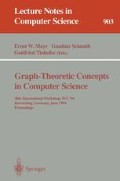Abstract
The classical double pushout approach to the algebraic theory of graph grammars is extended to multilevel graph representations, where parts of graphs are not visible and the information can be restored via the explicit application of productions. The notions of applicability and derivation are investigated and the compatibility of the representations with the derivations is shown. Production mechanisms for multilevel graph are motivated by problems in Visual Languages and the representation of Iconic Languages in particular.
Preview
Unable to display preview. Download preview PDF.
References
Ehrig, H.: Introduction to the Algebraic Theory of Graph Grammars. Springer Lect. Notes Comp. Sci. 73 (1979) 1–69
Ehrig, H., Habel, A., Kreowski, H.J., Parisi-Presicce, F.: From Graph Grammars to High Level Replacement Systems. Springer Lect. Notes Comp. Sci. 532 (1991) 269–287
Golin, E.J., Reiss, S.P.: The Specification of Visual Language Syntax. Proc. IEEE Workshop on Visual Languages, Rome (Italy) (1989) 105–110
Hesse, W.: Two level graph grammars. Springer Lect. Notes Comp. Sci. 73 (1979) 255–269
Helm, R., Marriot, K.: Declarative Specification of Visual Languages. Proc. IEEE Workshop on Visual Languages, Skokie (Illinois, USA) (1990) 98–103
Kennaway, J.R.: On On graph rewriting. Theoret. Comp. Sci. 52 (1987) 37–58
Löwe, M.: Extended Algebraic Graph Transformation. Technical Report, Technische Universitat Berlin feb 1991, 180 pages
Nagl, M.: A tutorial and bibliographical survey on Graph Grammars. Springer Lect. Notes Comp. Sci. 73 (1979) 70–126
Ollongren, A.: On multilevel graph grammars. Springer Lect. Notes Comp. Sci. 73 (1979) 341–349
Parisi-Presicce, F.: Single vs. Double pushout derivations of Graph. Springer Lect. Notes Comp. Sci. 657 (1993) 248–262
Parisi-Presicce, F., Ehrig, H., Montanari, U.: Graph Rewriting with unification and composition. Springer Lect. Notes Comp. Sci. 291 (1987) 496–514
Parisi-Presicce, F., Piersanti, G.: Multilevel Graph Grammars. Techn. Rep. 93/33, Dip. Matematica Pura ed Applicata, Universita' di L'Aquila, (1993)
Parisi-Presicce, F., Piersanti, G.: Graph Based Modelling of Visual Languages. in preparation
Pratt, T.W.: Pair grammars, Graph Languages and string to graph transformations. J. Comput. System Sci. 5 (1971) 560–595
Raoult, J.C.: On graph rewriting. Theoret. Comp. Sci. 32 (1984) 1–24
Author information
Authors and Affiliations
Editor information
Rights and permissions
Copyright information
© 1995 Springer-Verlag Berlin Heidelberg
About this paper
Cite this paper
Parisi-Presicce, F., Piersanti, G. (1995). Multilevel graph grammars. In: Mayr, E.W., Schmidt, G., Tinhofer, G. (eds) Graph-Theoretic Concepts in Computer Science. WG 1994. Lecture Notes in Computer Science, vol 903. Springer, Berlin, Heidelberg. https://doi.org/10.1007/3-540-59071-4_37
Download citation
DOI: https://doi.org/10.1007/3-540-59071-4_37
Published:
Publisher Name: Springer, Berlin, Heidelberg
Print ISBN: 978-3-540-59071-2
Online ISBN: 978-3-540-49183-5
eBook Packages: Springer Book Archive

